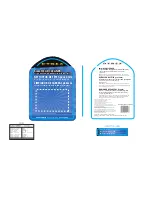
TB8100 Service Manual
Power Management Unit Fault Finding
245
© Tait Electronics Limited September 2006
2.
Set the current limit on the main input power supply to 2.5A.
3.
Slowly increase the main input power supply voltage, taking note of
the input current, the output voltage and the gate signal of the PFC
FETs (Q305, Q306).
The input current should increase in proportion to the input voltage
until approximately 1A, where it will drop as the boost converter
starts. The output voltage should regulate when the input voltage
reaches approximately 11VDC. If the input current does drop, go to
. If it does not drop before the input voltage reaches 15VDC,
replace the PFC control card and repeat this task. If the fault is still
present, replace the AC module and go to
4.
Measure the 400VDC bus at the test points on the bottom of the AC
converter board, as shown in
. The voltage
should be greater than 300VDC. If it is, go to
. If it is not,
replace the PFC control card and repeat this task. If the fault is still
present, replace the AC module and go to
5.
Check the gate signal of the PFC FETs (Q305, Q306). The pulse
width should change with input voltage. If it does, go to
it does not, replace the PFC control card and repeat this task.
Task 5 —
Check Regulation
and Efficiency
1.
Increase the current limit of the main input power supply to approx-
imately 5–10W at 28VDC.
Note
The current limit should be relative to the load you are using.
Remember also that the converter will be only approximately 34%
efficient at this low voltage (having been designed to operate on a
minimum of 88VAC).
2.
Connect a load to the PA output. Check that the output voltage does
not lose regulation. If it does lose regulation, go to
. If it does
not lose regulation, go to
.
3.
Measure the 400VDC bus at the test points on the bottom of the AC
converter board. The voltage should be greater than 300VDC. If it
is, replace the HVDC and microprocessor card and repeat this task. If
it is not, replace the PFC control card and repeat this task. If the fault
is still present, replace the AC module and go to
4.
Measure the input voltage and current and calculate the input power.
Measure the output voltage and current and calculate the output
power.
5.
Calculate the efficiciency by dividing the input power by the output
power. The expected efficiency of the AC converter while operating
in test mode is 34% ±10%. If the efficiency is within the limits, go
to
. If it is outside the limits, replace the
AC module and go to
.
Summary of Contents for TB8100
Page 1: ...TB8100 base station Service Manual MBA 00016 02 Issue 2 September 2006...
Page 62: ...62 Reciter Circuit Description TB8100 Service Manual Tait Electronics Limited September 2006...
Page 64: ...64 Reciter Circuit Description TB8100 Service Manual Tait Electronics Limited September 2006...
Page 66: ...66 Reciter Circuit Description TB8100 Service Manual Tait Electronics Limited September 2006...
Page 68: ...68 Reciter Circuit Description TB8100 Service Manual Tait Electronics Limited September 2006...
Page 98: ...98 Reciter Fault Finding TB8100 Service Manual Tait Electronics Limited September 2006...
Page 108: ...108 Reciter Board Replacement TB8100 Service Manual Tait Electronics Limited September 2006...
Page 110: ...110 Reciter Spare Parts TB8100 Service Manual Tait Electronics Limited September 2006...
Page 112: ...112 Reciter Spare Parts TB8100 Service Manual Tait Electronics Limited September 2006...
Page 200: ...200 Power Amplifier Spare Parts TB8100 Service Manual Tait Electronics Limited September 2006...
Page 288: ...288 Subrack Servicing TB8100 Service Manual Tait Electronics Limited September 2006...
Page 294: ...294 Subrack Servicing TB8100 Service Manual Tait Electronics Limited September 2006...
Page 306: ...306 TB8100 Service Manual Tait Electronics Limited September 2006...
















































